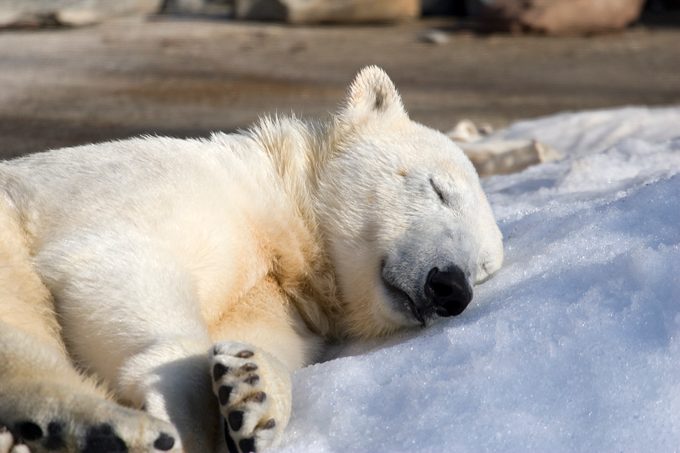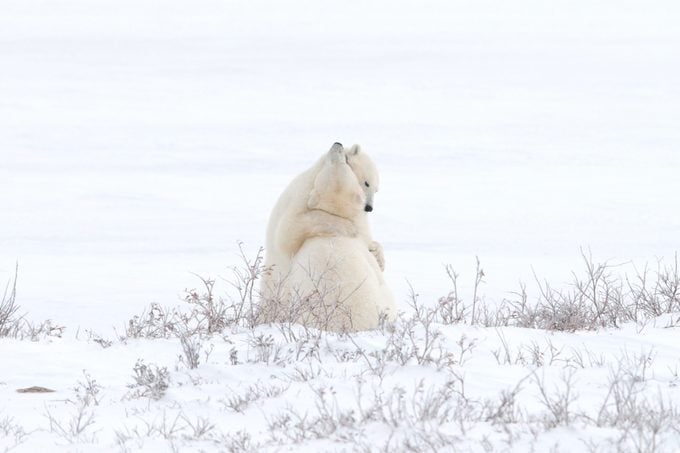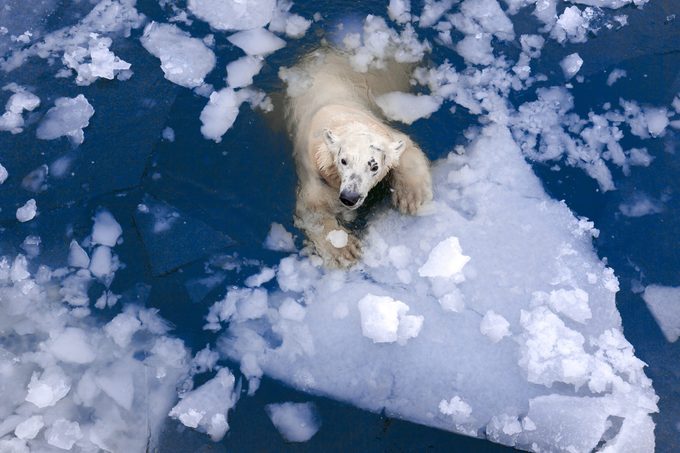How To Clean A Polar Ice Machine
A polar bear's entire existence revolves around sea ice. In fact, polar bears will cease to exist if sea ice disappears. Here's how it plays into their survival.
It's hard to imagine a polar bear without the backdrop of snow-covered, frozen tundra. Unlike any other land-loving bears, polar bears are actually considered marine mammals whose daily life is closely tied to the sea ice. "The name, polar bear in many languages even indicates this," says Thea Bechshoft, PhD, staff scientist at Polar Bears International, a non-profit that works to preserve polar bears and their sea ice home, who points out that in Danish, her native language, polar bears are called ice bears (isbjørn). Read on to find how ice is critical to their everyday life, the survival of the species, and if polar bears could adapt to a warmer climate.
Icy travel
Polar bears are well-equipped to travel the icy landscape. Their paws are nearly a foot wide, with small bumps on the bottom, called papillae that help them grip the ice. Not to mention their claws, each nearly two inches long, that help them grip the ice—and their prey. In the icy waters, the front paws act as paddles and back as rudders. While polar bears are strong swimmers, sea ice is essential for travel, because it takes a lot of energy to move their bodies through the water. "Swimming has been found to be five times as energetically demanding for a polar bear than walking," says Bechshoft. "Navigating the increasingly fragmented sea ice landscape can be energetically stressful, particularly for young cubs and for bears in poor body condition that are lacking a good layer of insulating fat. For them, swimming in the cold Arctic water carries with it the risk of hypothermia," she says. Find out how many polar bears are left in the world.
Cool naps
 virtualimages/Getty Images
virtualimages/Getty Images
Nature didn't skimp on equipping the polar bear for frigid conditions. Their super dense fur acts like insulation that prevents almost all heat loss. (Male polar bears can actually overheat when they run!) Though polar bears don't generally sleep on the ice, on a warm day, the sea ice serves as a cool spot to nap. "I've come across polar bears sleeping (heavily!) on the sea ice north of Svalbard a handful of times. On a warm day, the bears may be splayed out on its stomach on the ice, trying to dissipate some of the excess heat," Bechshoft says. Most of the time, the bears sleep in a shallow pit in the snow and use their front paw or a piece of ice as a pillow.
Frozen dinners
Polar bears are strong swimmers, but not fast enough to catch their main source of food—the ringed and bearded seal. Therefore, sea ice is critical for polar bears to use as a platform to hunt the seals. Seals cut breathing holes into the ice and when they pop up for air, the waiting polar bear catches its dinner. Other times, seals bask on top of the ice, allowing the polar bear an opportunity to stalk and kill it. Seals are the polar bear's first choice of food because they have a thick layer of fat and are calorie-dense. Without the sea ice for a hunting platform, polar bears don't have access to seals. "A lack of seals means skinnier bears that produce fewer and smaller cubs," Bechshoft notes. "A polar bear can eat 10 to 20 percent of its own body weight in one go, and on average needs to ingest the caloric equivalent to one adult ringed seal per 1 to 1.5 weeks in order to survive long-term," she says.
Melting courtship
 HuntedDuck/Getty Images Polar bears are loners, except for mating and parenting. In the spring, males start sniffing for females, closely following the scent the female leaves behind on the sea ice via the sweat glands under her paws. Once they find each other, it's a short romance. "They may spend a week or so getting to know each other before mating. After that, the male goes on his way, and the female continues to hunt for seals on her own," says Elisabeth Kruger, senior program officer, arctic wildlife, World Wildlife Fund. But, if the sea ice is fragmented, picking up a female's scent becomes more difficult and harder for the male to follow. Sea ice is equally vital for a bear to become pregnant. Kruger says pregnant females must eat enough seals within four months of mating in order to get and stay pregnant and deliver a viable cub(s).
HuntedDuck/Getty Images Polar bears are loners, except for mating and parenting. In the spring, males start sniffing for females, closely following the scent the female leaves behind on the sea ice via the sweat glands under her paws. Once they find each other, it's a short romance. "They may spend a week or so getting to know each other before mating. After that, the male goes on his way, and the female continues to hunt for seals on her own," says Elisabeth Kruger, senior program officer, arctic wildlife, World Wildlife Fund. But, if the sea ice is fragmented, picking up a female's scent becomes more difficult and harder for the male to follow. Sea ice is equally vital for a bear to become pregnant. Kruger says pregnant females must eat enough seals within four months of mating in order to get and stay pregnant and deliver a viable cub(s).
Polar bears in the backyard
A hungry polar bear isn't picky. "They will try to eat anything that looks and smells like it could be food," says Kruger. But even when they find other food sources, such as snow geese eggs, they aren't calorie-dense enough to fill up a polar bear's belly. "As sea ice decreases at a rate of about 4.6 percent a decade, some polar bears at the southern edges of the species' range are spending five to six months on land, with very few seals to eat. Without sea ice and seals, polar bears are left to search for other food sources," says Kruger. "This can lead them into communities, where garbage dumps, sled dog yards, and human food storage offer easy pickings." That's not a good scenario for anyone. "Communities, government, and WWF are working together to keep both bears and people safe," Kruger says.
Vanishing sea ice
 Evgeny555/Getty Images Yes, polar bears hunt, mate, and even sleep on sea ice, but it's more than just a frozen platform. "Sea ice is absolutely essential for the day-to-day survival of polar bears," says Kruger. "It is an entire ecosystem inhabited by plankton and micro-organisms, which support a rich food chain that nourishes seals, that in turn become prey for polar bears. It is the very foundation and defining characteristic of the Arctic marine ecosystem," says Kruger. Yet, sea ice is vanishing at an alarming rate—especially in the Arctic. "Rapid loss of sea ice is the primary threat to the polar bears' long-term survival. Our reliance on fossil fuels and the resulting climate change is causing a 13 percent decline per decade in the sea ice extent," says Bechshoft. When polar bears spend longer periods searching forgoing food, their health and the health of their cubs suffer. "Unhealthy bears can mean lower reproduction rates, higher cub mortality—and eventually, local extinction. The main causes of death for cubs are lack of food or lack of fat on nursing mothers," Kruger says. "We anticipate that polar bear populations will decline due to the loss of sea ice habitat."
Evgeny555/Getty Images Yes, polar bears hunt, mate, and even sleep on sea ice, but it's more than just a frozen platform. "Sea ice is absolutely essential for the day-to-day survival of polar bears," says Kruger. "It is an entire ecosystem inhabited by plankton and micro-organisms, which support a rich food chain that nourishes seals, that in turn become prey for polar bears. It is the very foundation and defining characteristic of the Arctic marine ecosystem," says Kruger. Yet, sea ice is vanishing at an alarming rate—especially in the Arctic. "Rapid loss of sea ice is the primary threat to the polar bears' long-term survival. Our reliance on fossil fuels and the resulting climate change is causing a 13 percent decline per decade in the sea ice extent," says Bechshoft. When polar bears spend longer periods searching forgoing food, their health and the health of their cubs suffer. "Unhealthy bears can mean lower reproduction rates, higher cub mortality—and eventually, local extinction. The main causes of death for cubs are lack of food or lack of fat on nursing mothers," Kruger says. "We anticipate that polar bear populations will decline due to the loss of sea ice habitat."
What can we do?
The decline in the polar bear population isn't just as an estimate. It's already happening. "Over the past 30 years, the western Hudson Bay has lost 30 percent of its bears, while the southern Beaufort Sea population has declined by 50 percent," says Bechshoft. "Overall scientists predict that as the Arctic continues to warm, two-thirds of the world's 20,000 to 25,000 polar bears could disappear within this century. Yet the future doesn't have to be so grim for the polar bear. Dr. Bechshoft says reducing greenhouse gas emissions in the immediate future will help, but combatting climate change is the most important factor in protecting polar bears and ensuring their existence for generations to come. "The most important step anyone can take to do this is to vote and speak up, vote with the climate in mind, in each and every election, and let your representatives know you support bold climate action and a swift transition to clean energy sources," urges Bechshoft. You can also donate to Polar Bears International and share these 12 adorable polar bear pictures to raise awareness about their plight.
How To Clean A Polar Ice Machine
Source: https://www.rd.com/article/why-do-polar-bears-need-ice-to-survive/
Posted by: gasshatry1988.blogspot.com

0 Response to "How To Clean A Polar Ice Machine"
Post a Comment